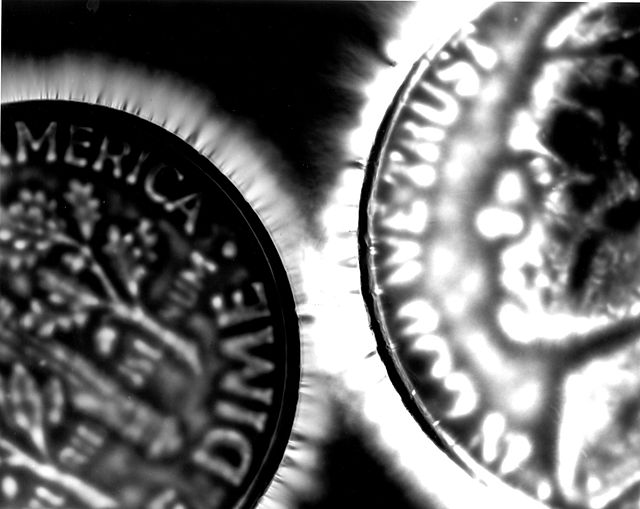Kirlian photography is a collection of photographic techniques used to capture the phenomenon of electrical coronal discharges. It is named after Soviet scientist Semyon Kirlian, who, in 1939, accidentally discovered that if an object on a photographic plate is connected to a high-voltage source, an image is produced on the photographic plate.
The technique has been variously known as
"electrography",
"electrophotography",
"corona discharge photography" (CDP),
"bioelectrography",
"gas discharge visualization (GDV)",
"electrophotonic imaging (EPI)", and, in Russian literature, "Kirlianography".
Kirlian photograph of a fingertip, 1989
Kirlian photograph of a fingertip
Kirlian photograph of two coins
Kirlian photograph of a Coleus leaf
A corona discharge is an electrical discharge caused by the ionization of a fluid such as air surrounding a conductor carrying a high voltage. It represents a local region where the air has undergone electrical breakdown and become conductive, allowing charge to continuously leak off the conductor into the air. A corona discharge occurs at locations where the strength of the electric field around a conductor exceeds the dielectric strength of the air. It is often seen as a bluish glow in the air adjacent to pointed metal conductors carrying high voltages, and emits light by the same mechanism as a gas discharge lamp. Corona discharges can also happen in weather, such as thunderstorms, where objects like ship masts or airplane wings have a charge significantly different from the air around them.
Long exposure photograph of corona discharge on an insulator string of a 500 kV overhead power line. Corona discharges represent a significant power loss for electric utilities.
The corona discharge around a high-voltage coil
Corona discharge from a spoon attached to the high voltage terminal of a Tesla coil.
A variety of forms of corona discharge, from various metal objects. Notice, especially in the last two pictures, how the discharge is concentrated at the points on the objects.








